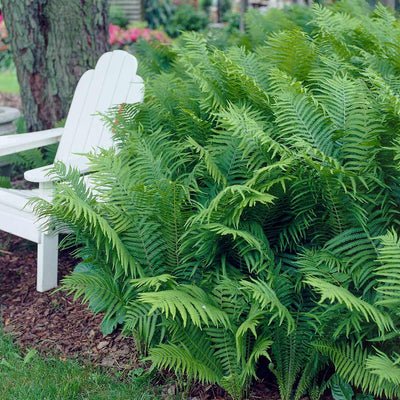Growing Healthy Fern Plants:
Tips and Information Ferns are a diverse group of plants that add a touch of elegance and lushness to any indoor or outdoor space. Their delicate fronds and unique reproductive methods make them captivating additions to gardens, terrariums, and indoor plant collections. To successfully grow and care for fern plants, it's important to understand their specific requirements and follow some essential guidelines. In this article, we will provide you with valuable information and tips to help you cultivate thriving ferns.
Understanding Ferns:
Ferns belong to a group of plants called Pteridophytes, characterized by their vascular tissue and reproductive structures known as sporangia. Unlike flowering plants that reproduce through seeds, ferns reproduce via spores. These spores develop into gametophytes, which produce male and female gametes, eventually leading to the formation of new fern plants. Ferns come in a wide variety of sizes, shapes, and textures. Some have finely dissected fronds, while others have broad, leathery leaves. They can thrive in various environments, from damp and shaded woodlands to rocky crevices and even deserts. This diversity means a fern species is suitable for almost any gardening situation.
Tips for Growing Healthy Ferns:
Choose the Right Fern Variety: Different fern species have varying requirements. Some prefer bright, indirect light, while others thrive in deep shade. Research the specific needs of the fern variety you choose to ensure you can provide the optimal conditions.
Light Requirements: Most ferns prefer filtered or indirect light, as direct sunlight can scorch their delicate fronds. Place your ferns near windows with sheer curtains or in spots that receive dappled sunlight throughout the day.
Soil and Potting: Ferns thrive in well-draining, slightly acidic soil. Use a mix of peat moss, perlite, and pine bark to create a suitable growing medium. When potting, make sure the container has drainage holes to prevent waterlogging.
Watering: Consistent moisture is crucial for ferns, but they dislike waterlogged soil. Water when the top inch of soil feels slightly dry to the touch. Water the ground directly, avoiding wetting the fronds. A humidity tray filled with water and pebbles near the fern can help maintain the required moisture levels.
Humidity: Ferns generally thrive in high-humidity environments. To increase humidity, you can mist the fronds regularly, use a room humidifier, or place a tray of water near the plants. Grouping ferns also helps create a microclimate of higher humidity. Temperature: Most ferns prefer temperatures between 60-75°F (15-24°C). Avoid exposing them to cold drafts or sudden temperature fluctuations, as they can be sensitive to these changes.
Fertilization: Feed your ferns with a balanced liquid fertilizer diluted to half strength during the growing season (spring and summer) every 4-6 weeks. Reduce or stop fertilizing during the dormant period (fall and winter). Pruning and Maintenance: Regularly remove yellowing or dead fronds to promote new growth. Grooming your fern will keep it neat and prevent the plant from wasting energy on unhealthy foliage.
Repotting: Ferns may need repotting every 1-2 years, as they can become root-bound. Choose a slightly larger pot and fresh potting mix during repotting. This gives the plant more room to grow and rejuvenates the soil. Pest and Disease Control: Watch for pests like aphids, mealybugs, and scale insects. If infestations occur, isolate the affected plant and treat it with insecticidal soap or neem oil. Proper air circulation and avoiding overwatering can help prevent fungal diseases.
Choosing the Right Location:
Whether you're growing ferns indoors or outdoors, selecting the right location is vital. Outdoors consider factors like sunlight exposure, soil type, and drainage. Indoors, think about the room's natural light patterns and humidity levels.
Companion Plants: Ferns can complement other plants in your garden or indoor space. Combine them with shade-loving flowering plants, such as hostas, astilbes, and impatiens, to create visually appealing and diverse plant arrangements.
Popular Fern Varieties: Boston Fern (Nephrolepis exaltata): One of the most common indoor ferns, known for its feathery fronds. It prefers bright indirect light and high humidity. *Maidenhair Fern (Adiantum spp.): Recognizable by its delicate fan-shaped fronds, this fern requires bright indirect light and consistent moisture.
Bird's Nest Fern (Asplenium nidus): Characterized by its wavy, crinkled fronds that resemble a bird's nest, this fern thrives in medium to low light conditions.
Japanese Painted Fern (Athyrium niponicum): This outdoor fern features metallic blue-green fronds with purple and silver highlights. It prefers partial shade and well-draining soil. *Staghorn Fern (Platycerium spp.): An epiphytic fern that grows on trees or structures. It has distinctive antler-like fronds and is often mounted on boards.
Conclusion:
Growing ferns can be rewarding, as these plants bring a sense of natural beauty and tranquility to any space. By understanding their specific needs and following the tips mentioned above, you can cultivate healthy and vibrant ferns that thrive indoors and outdoors. Remember that patience and observation are essential; you'll need to adjust your care routine based on your ferns' responses. With dedication and the right approach, you can enjoy the lush and captivating presence of ferns in your surroundings.



